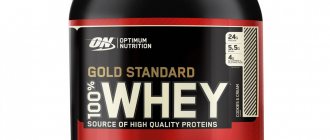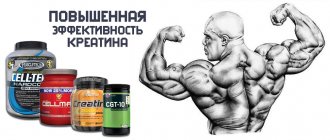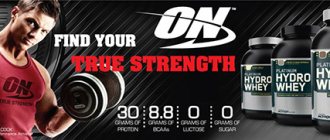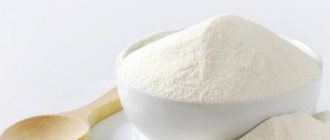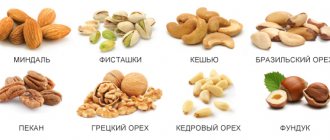Protein is a source of essential protein for the body. The substance is involved in the construction of all organs and tissues. Protein is necessary for the growth of strong tissues, rapid regeneration of damaged areas and reducing the risk of injury.
It is known that if a sufficient amount of protein is present in the body, this leads to a drop in the level of triglycerides in the blood and a decrease in total cholesterol. Regular consumption of protein foods ensures uninterrupted functioning of the immune system, increased endurance and strength.
Why is it important to take protein correctly?
Protein should be added to the daily diet according to the developed recommendations. This will ensure maximum effectiveness of the supplement.
Proper consumption of a product enriched with protein components helps athletes:
- - increase the rate of muscle mass growth;
- - avoid a decrease in muscle volume when losing weight.
Sports nutrition with proteins
There is no better way to build muscle mass faster than eating plenty of protein. Special sports nutrition that contains this substance is inherently a kind of catalyst for muscle growth. You can purchase a sports nutrition complex in specialized stores, where sellers will tell you about all the contraindications of protein.
Bodybuilding and other strength disciplines require an uninterrupted supply of protein, because it is constantly spent on the formation and growth of new muscle tissue, maintains the athlete’s mobility and maintains joints and ligaments in working condition.
On the other hand, the opinion about the use of proteins among athletes is not so clear. Adherents of strength sports are actually divided into two camps. The first advocate the use of protein supplements and believe that without them it is too difficult to build muscle mass. Others call such sports nutrition “all chemicals” and talk about many side effects and contraindications of protein.
General principles of protein intake
Supportive role of protein
The key to successful muscle tissue growth is a properly composed diet. Protein acts as a supplement, that is, an additional growth stimulator.
It works in conjunction with the nutrients obtained from everyday food. Protein should enrich the athlete's daily meal by 30% and no more.
The importance of combining proteins and carbohydrates
In addition, it is important to remember the importance of complex carbohydrates in building muscle tissue. It is carbohydrate foods that contribute to the accumulation of the necessary amount of muscle energy for subsequent muscle growth. When planning your daily menu, you should strive to get the maximum amount of carbohydrates from regular food.
An athlete is recommended to consume about 2-3 protein shakes per day. Whey or multi-component protein is usually used as a stimulant in the process of gaining muscle mass.
Lowering values
- Thrombosis of veins and arteries, thrombotic conditions;
- Vitamin K deficiency or disturbance of its metabolism (including malabsorption syndrome);
- Diseases of the liver (hepatitis, cirrhosis, failure, Budd-Chiari syndrome) and kidneys;
- Infectious processes (sepsis, shock), intoxication;
- Oncological diseases;
- DIC syndrome;
- Immunodeficiency conditions;
- Complications of pregnancy and childbirth (critical period about 2 months after birth);
- Therapy with anticoagulants (heparin, warfarin).
Read more about blood clotting indicators
- Coagulogram: main indicators
- Fibrinogen in the blood
- APTT
- Prothrombin
- Thrombin time
- D-dimer
- Lupus anticoagulant
- Antithrombin III
- Plasminogen
- Protein C
- Protein S free
- Coagulogram during pregnancy
Recommendations for taking protein when losing weight
Rapid weight loss
If a person needs to lose extra pounds in a minimum period of time, he can include protein intake 3 times a day in his daily diet. When following such nutritional tactics, a person takes a protein shake, replacing breakfast, lunch and dinner with it.
Between these main meals you should definitely have small snacks. Enriching nutrition during a strict diet is allowed with low-calorie foods rich in vitamins and minerals.
When following such a diet, a person runs the risk of rapidly gaining the same (or more) weight immediately after the end of strict dietary restrictions. In addition, rapid loss of body weight has a detrimental effect on health. Sudden weight loss leads to weakness and fatigue, nervousness and irritability, exhaustion, dizziness and decreased immunity.
The maximum period of a strict diet with protein intake three times a day should not exceed 3 weeks. A longer restriction of nutritious food intake can lead to irreversible changes in the human body and cause the development of a serious disease.
When following a strict diet, preference should be given to multi-component protein. This substance contains a large number of useful ingredients. It satisfies the feeling of hunger better and maintains a feeling of fullness for a longer period than single-component formulations.
Protein for kids: what does the science say?
Protein for kids: what does the science say?
Protein is important for proper development and growth, but first find out how much protein your child needs and what kind of protein is best to consume.
Children of all ages need healthy nutrition to meet their daily growth and development needs. For a growing child, protein is of particular importance due to its various functions in the body.
Due to the popularity of protein supplements for athletes, especially among teenagers and young adults, it may be a good idea to make sure your kids are getting everything they need by drinking protein shakes. But should you consume a protein shake after class or study? Let's take a closer look.
Why do children need protein?
During childhood, protein becomes incredibly important for maintaining normal body function and providing the building blocks to support growth. Because growth occurs at such a rapid rate throughout childhood, the amount of protein a child consumes is absolutely critical. A low amount of protein in the diet leads to reduced growth development compared to children who consumed a sufficient amount of protein [1].
On the other hand, increased protein intake throughout childhood has been found to be associated with an increased risk of being overweight or obese in later childhood and early adulthood. [2] Previous studies indicate that this risk is further increased with higher intakes of animal proteins compared to plant proteins [3,4]
However, it is important to keep in mind that this only occurs when protein intake is exceptionally high and accounts for more than 20% of total daily calories. Based on science, 12 to 15 percent of children's daily caloric intake should come from protein.
What is the best protein for children?
When you're trying to figure out which protein-rich foods are best for your children, remember that unless your child has dietary restrictions, animal sources of protein, such as meat and dairy, are better than plant-based sources for promoting growth and development. , as well as recovery after training.
One of the reasons for this is amino acids , in particular leucine . Leucine is a major regulator of protein . While most animal proteins contain more than enough leucine to stimulate protein synthesis, plant sources are not as rich in it. Additionally, studies have shown that even when leucine content is the same, animal proteins such as milk or beef provide a better protein synthesis response compared to plant protein [5,6].
Therefore, it is better to use animal sources such as milk, cottage cheese, yogurt, lean meat and eggs to provide the bulk of your daily protein intake. Use healthy snacks like nuts, peanut butter and hummus to fill nutritional gaps, but not as your main source of protein. And while a milkshake or yogurt shake can be a healthy, protein-rich snack, a balanced diet rich in whole foods should provide adequate nutrition for most children.
How much protein do children need?
How much protein does your child really need every day? The answer depends on many factors, including age, body size and activity level. Big children need more protein than small children, and an active child will need more protein than one who sits still.
However, adequate macronutrient intake should always be based on total daily calories. Therefore, daily caloric intake is the best way to accurately determine your protein needs.
According to updated dietary guidelines published by the British Nutrition Scientific Advisory Committee , which advises the UK on nutrition and health, men and women aged 4 to 6 years should consume an average of approximately 1500 and 1400 calories per day, respectively [7 ]. However, between the ages of 16 and 18, the number is about 3,000 calories per day for men and 2,450 per day for women.
Based on these same nutritional guidelines, children ages 4 to 6 should consume about 20 grams of quality protein per day, while teenagers should consume 42 to 55 grams per day. This amount can easily be achieved through high-quality lean animal protein and common high-protein dairy sources such as milk, Greek yogurt and cottage cheese.
This value increases for athletes due to the increased demand for amino acids to help the body recover after exercise. Regardless, even teenage athletes don't need more than about 1.4 grams of protein per kilogram of body weight per day. [8]
Is protein safe for children?
One of the most important questions you ask yourself before giving anything to your child is “ Is it safe ?” In the case of protein supplements, the answer to this question is a resounding yes . However, just because something is safe doesn't mean protein should be a major part of a child's diet. If your protein intake is too high, it may increase your risk of obesity in the future. [4]
Since children's protein needs are still relatively low compared to adults, additional protein from protein shakes can easily exceed the daily requirement. So, while a protein shake is safe for children and is an excellent source of protein when used as a snack, regularly adding a protein shake to your child's daily diet is probably not necessary if he or she is getting enough protein in their diet.
How much protein does a teenager need to build muscle?
During adolescence, there is often an increase in physical activity through participation in sports competitions and physical activity methods, such as training in sports clubs.
While the increased activity and growth associated with puberty lead to increased protein requirements, total protein intake should increase by 12-15% . For most teenage athletes, this is 65-80 grams of protein per day.
Most available protein supplements provide 20-25 grams of protein per serving—about 25% of your daily value! So even for teenage athletes, a trip to the cafeteria is probably a better option than a can of protein.
Should you give your child a protein shake?
The choice is entirely up to you. Protein supplements are safe for consumption by people of all ages, but protein requirements in children are so relatively low that all children can easily meet their protein needs with a normal, healthy, varied diet.
If you decide to buy protein for your child or teen, look for a high-quality whey or protein isolate with approximately 20 grams of protein per serving, to be used only after workouts. So, if your child is an athlete, it's safe to swap fruit for protein bars and add a protein drink every now and then, but it's not necessary.
Literature:
- Michaelsen, K. F., Larnkjær, A., & Mølgaard, C. (2012). Amount and quality of dietary proteins during the first two years of life in relation to NCD risk in adulthood. Nutrition, Metabolism and Cardiovascular Diseases, 22(10), 781-786.
- Wright, M., Sotres-Alvarez, D., Mendez, M. A., & Adair, L. (2017). The association of trajectories of protein intake and age-specific protein intakes from 2 to 22 years with BMI in early adulthood. British Journal of Nutrition, 117(5), 750-758.
- Halkjær, J., Olsen, A., Overvad, K., Jakobsen, M. U., Boeing, H., Buijsse, B., … & Wareham, N. J. (2011). Intake of total, animal and plant protein and subsequent changes in weight or waist circumference in European men and women: the Diogenes project. International Journal of Obesity, 35(8), 1104.
- Lind, M. V., Larnkjær, A., Mølgaard, C., & Michaelsen, K. F. (2017). Dietary protein intake and quality in early life: impact on growth and obesity. Current Opinion in Clinical Nutrition & Metabolic Care, 20(1), 71-76.
- Tang, J. E., Moore, D. R., Kujbida, G. W., Tarnopolsky, M. A., & Phillips, S. M. (2009). Ingestion of whey hydrolysate, casein, or soy protein isolate: effects on mixed muscle protein synthesis at rest and following resistance exercise in young men. Journal of Applied Physiology, 107(3), 987-992.
- van Vliet, S., Burd, N. A., & van Loon, L. J. (2015). The Skeletal Muscle Anabolic Response to Plant-versus Animal-Based Protein Consumption1. The Journal of Nutrition, 145(9), 1981-1991.
- Scientific Advisory Committee on Nutrition. (2012). Dietary reference values for energy. The Stationery Office.
- Boisseau, N., Vermorel, M., Rance, M., Duché, P., & Patureau-Mirand, P. (2007). Protein requirements in male adolescent soccer players. European Journal of Applied Physiology, 100(1), 27-33.
Gradual weight loss
If a person wants to get rid of excess fat without harming his health, he should choose a gradual weight loss method. In this case, the result will be stable.
The second way to lose weight involves taking protein 2-3 times a day. However, unlike the first method, protein shakes should not be taken as main meal replacements, but during snacks.
Thus, a person provides himself with a useful addition to his main diet, consisting of healthy food. Protein entering the body ensures the normalization of metabolic processes, preventing overload and disease of the digestive system.
During the day, you should take whey protein, preferably whey isolate. In the evening, you can add casein and multicomponent protein to your food.
Myths about the dangers of protein
If you read publications on the Internet and in newspapers, you can come to the conclusion that protein is harmful and dangerous for the body. The press reports side effects that affect many organs. There is even an assumption that protein is more dangerous in its action than anabolic steroids. They say that regular use of the supplement damages the liver and kidneys, and also harms many internal organs.
As a rule, all these statements have no basis, except for some exceptions, which will be discussed below.
Rules for consuming protein during the rest period
While at the recovery stage after long and intense training, an athlete should not forget about proper nutrition. Taking a protein drink will help saturate the body with useful substances and overcome the feeling of fatigue.
A cocktail with protein ingredients should be consumed in several servings throughout the day. Protein is usually taken between main meals. The cocktail helps accelerate the production of anabolic hormones involved in building muscle tissue. Whey protein should be consumed in the morning.
Children's protein on iHerb
Sports nutrition for children can be purchased in the verified iHerb online catalog with delivery worldwide. The products of this store are reliable and affordable. We have highlighted two of the best and vitamin-rich options.
Nature's Plus Chocolate Shake
Nature's Plus Chocolate Shake is a vegetarian product, a protein mixture created from three components - peas, rice and soy. Contains no GMOs. A measuring spoon is included. Suitable for both kids and teenagers.
One scoop per day is mixed with juice, water or skim milk (no blender needed!). By drinking this drink every day, the child receives not only the daily protein requirement, but also a portion of vitamins: B12, zinc, calcium, iodine, selenium, etc.
Nature's Plus Chocolate Shake from iHerb
Nature's One Nutritional Drink
Nature's One Vanilla Protein is kosher, no artificial flavors, no GMOs. Suitable for children and adult schoolchildren, as well as boys and girls under 18 years old who lead an active lifestyle. The powder can be used as the only source of protein, BUT under the supervision of a physician.
In addition to protein, it contains 29 beneficial vitamins and minerals. Serving Size: 3 level scoops (52 g) for 240 ml prepared mixture. The powder just needs to be mixed with water or fruit in a blender. One package contains 360 grams.
Nature's One Nutritional Drink
Of course, protein powder cannot completely replace a healthy and proper children's diet. It is used only if the child’s body really needs support in the form of protein and vitamins.
( 78 ratings, average: 5.00 out of 5)
Increased blood levels
The main reason for the increase in the concentration of protein C in the blood is the use of oral contraceptives, due to which the balance of the coagulation and anticoagulation systems is disturbed. Another reason for the increase in the concentration of protein C in the blood is the period of gestation. If a pregnant woman has previously been diagnosed with thrombosis of the veins of the lower extremities, then the doctor should give a referral for a study, although it is not included in the screening program. Typically, elevated anticoagulant levels do not have important diagnostic value.
Treatment of abnormalities
An analysis to determine the concentration of protein C is important in clinical practice, especially for patients with thrombosis or hereditary diseases associated with disruption of the anticoagulant system. To quickly correct physiological deviations from the norm, it is important to increase immunity, follow a diet, normalize the drinking regime, move more and actively engage in sports. When you receive the result of an analysis to determine the activity of protein C, you should immediately contact your doctor: phlebologist, gynecologist, surgeon, hepatologist, nephrologist, infectious disease specialist. In order to quickly normalize the patient's condition, the doctor may prescribe injections of sodium heparin or warfarin.
Composition of protein mixtures
Specialized sports nutrition is traditionally divided into two main types - fast and slow. The differences between them are in composition and purpose.
Fast sports nutrition releases a lot of nutrients. And they are absorbed in a short period of time. Athletes take this type of nutrition about 5-6 times a day, starting in the morning. Stores offer options based on egg, milk or whey protein. Of course, each of these types of sports mixtures has contraindications.
Meals with slow-acting proteins serve to replenish the body's resources during long breaks between meals or during sleep. Casein and soy mixtures are available on the market. Thanks to the use of such sports nutrition, you can maintain the result achieved in the last workout and consolidate it. Athletes often resort to consuming slow-release protein mixtures instead of regular food.
Indications and contraindications
The study is prescribed if hereditary thrombophilia is suspected, especially if there are relatives in the family who suffer from this pathology. For prognostic purposes, the analysis may be indicated to assess the degree of risk of developing thrombosis or thromboembolism before taking hormonal contraceptives. The analysis is also used for the differential diagnosis of coagulation system disorders (for example, in liver disease or in the postoperative period). The study is prescribed as part of pregnancy planning or in cases of recurrent miscarriage, as well as before starting therapy with indirect anticoagulants.
Hemorrhoids kill the patient in 79% of cases
Relative contraindications to testing protein C levels are the acute phase of an infectious disease, sepsis or acute thrombosis. It is also not recommended to perform the test while taking oral contraceptives or anticoagulants, since the results will not be reliable (warfarin reduces the activity of protein C). In this case, you need to take a break from treatment, during which a study should be carried out.

